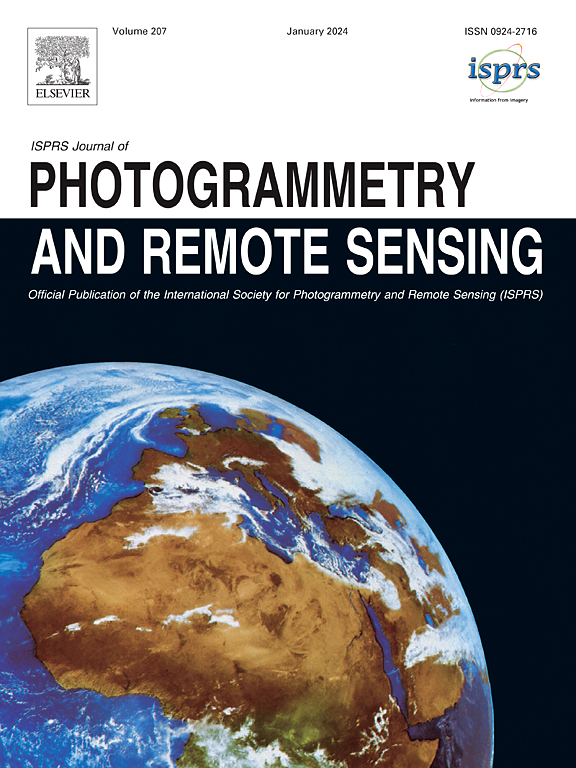A novel deep learning algorithm for broad scale seagrass extent mapping in shallow coastal environments
IF 10.6
1区 地球科学
Q1 GEOGRAPHY, PHYSICAL
ISPRS Journal of Photogrammetry and Remote Sensing
Pub Date : 2025-02-01
DOI:10.1016/j.isprsjprs.2024.12.008
引用次数: 0
Abstract
Recently, the importance of seagrasses in the functioning of coastal ecosystems and their ability to mitigate climate change has gained increased recognition. However, there has been a rapid global deterioration of seagrass ecosystems due to climate change and human-mediated disturbances. Accurate broad-scale mapping of seagrass extent is necessary for seagrass conservation and management actions. Traditionally, these mapping methods have primarily relied on spectral information, along with additional data such as manually designed spatial/texture features (e.g., from the Gray Level Co-Occurrence Matrix) and satellite-derived bathymetry. Despite the widely reported success of prior methods in mapping seagrass across small geographic areas, two challenges remain in broad-scale seagrass extent mapping: 1) spectral overlap between seagrass and other benthic habitats that results in the misclassification of coral/macroalgae to seagrass; 2) seagrass ecosystems exhibit spatial and temporal variability, most current models trained on data from specific locations or time periods encounter difficulties in generalizing to diverse locations or time periods with varying seagrass characteristics, such as density and species. In this study, we developed a novel deep learning model (i.e., Seagrass DenseNet: SGDenseNet) based on the DenseNet architecture to overcome these difficulties. The model was trained and validated using surface reflectance from Sentinel-2 MSI and 9,369 field data samples from four diverse regional shallow coastal water areas. Our model achieves an overall accuracy of 90% for seagrass extent mapping. Furthermore, we evaluated our deep learning model using 1,067 seagrass field data samples worldwide, achieving a producer’s accuracy of 81%. Our new deep learning model could be applied to map seagrass extents at a very broad-scale with high accuracy.
一种基于深度学习的浅海环境大比例尺海草分布图绘制算法
最近,人们越来越认识到海草在沿海生态系统功能中的重要性及其缓解气候变化的能力。然而,由于气候变化和人为干扰,全球海草生态系统正在迅速恶化。准确的海草范围测绘是海草保护和管理的必要条件。传统上,这些制图方法主要依赖于光谱信息,以及人工设计的空间/纹理特征(例如,来自灰度共生矩阵)和卫星衍生的水深测量等附加数据。尽管先前的方法在小地理区域海草制图中取得了广泛的成功,但在大尺度海草范围制图中仍然存在两个挑战:1)海草和其他底栖生物栖息地之间的光谱重叠导致珊瑚/大型藻类被错误地分类为海草;2)海草生态系统具有时空变异性,目前大多数基于特定地点或时间段数据训练的模型难以推广到具有不同海草特征(如密度和种类)的不同地点或时间段。在本研究中,我们基于DenseNet架构开发了一种新的深度学习模型(即海草DenseNet: SGDenseNet)来克服这些困难。该模型使用Sentinel-2 MSI的表面反射率和来自四个不同区域浅海水域的9,369个现场数据样本进行了训练和验证。我们的模型在海草范围映射方面达到了90%的总体精度。此外,我们使用全球1,067个海草田数据样本评估了我们的深度学习模型,实现了81%的生产者准确率。我们的新深度学习模型可以在非常广泛的范围内以高精度绘制海草范围。
本文章由计算机程序翻译,如有差异,请以英文原文为准。
求助全文
约1分钟内获得全文
求助全文
来源期刊

ISPRS Journal of Photogrammetry and Remote Sensing
工程技术-成像科学与照相技术
CiteScore
21.00
自引率
6.30%
发文量
273
审稿时长
40 days
期刊介绍:
The ISPRS Journal of Photogrammetry and Remote Sensing (P&RS) serves as the official journal of the International Society for Photogrammetry and Remote Sensing (ISPRS). It acts as a platform for scientists and professionals worldwide who are involved in various disciplines that utilize photogrammetry, remote sensing, spatial information systems, computer vision, and related fields. The journal aims to facilitate communication and dissemination of advancements in these disciplines, while also acting as a comprehensive source of reference and archive.
P&RS endeavors to publish high-quality, peer-reviewed research papers that are preferably original and have not been published before. These papers can cover scientific/research, technological development, or application/practical aspects. Additionally, the journal welcomes papers that are based on presentations from ISPRS meetings, as long as they are considered significant contributions to the aforementioned fields.
In particular, P&RS encourages the submission of papers that are of broad scientific interest, showcase innovative applications (especially in emerging fields), have an interdisciplinary focus, discuss topics that have received limited attention in P&RS or related journals, or explore new directions in scientific or professional realms. It is preferred that theoretical papers include practical applications, while papers focusing on systems and applications should include a theoretical background.
 求助内容:
求助内容: 应助结果提醒方式:
应助结果提醒方式:


